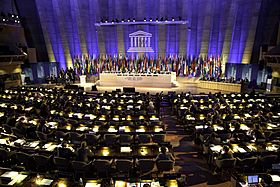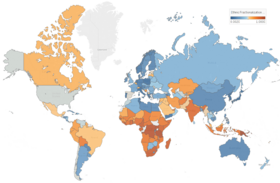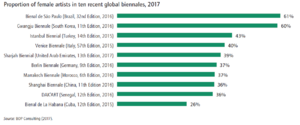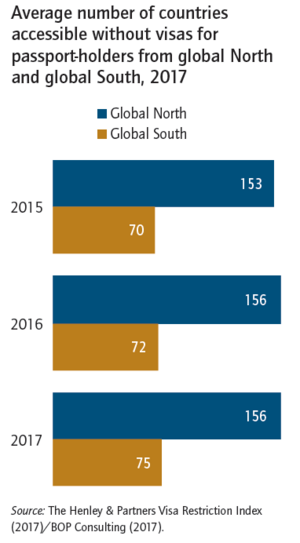Cultural diversity facts for kids
Cultural diversity is the quality of diverse or different cultures, as opposed to monoculture, the global monoculture, or a homogenization of cultures, akin to cultural evolution. The term "cultural diversity" can also refer to having different cultures respect each other's differences. It is often used to mention the variety of human societies or cultures in a specific region, or in the world as a whole. It refers to the inclusion of different cultural perspectives in an organization or society.
Contents
Characteristics
Cultural diversity can take several meanings:
- A balance to be achieved: thus, the idea of defence of cultural diversity through the promotion of actions in favour of "cultural minorities" said to be disadvantaged
- Preservation of "cultural minorities" thought to be endangered
- "Cultural protection" or "cultural exception" defends the social vision of culture against its commercialization. The cultural exception highlights the specificity of cultural products and services, including special recognition of cultural expressions by the European Union in its Declaration on Cultural Diversity. In this context, the objective is to defend against what is seen as a "commodification"—considered harmful to a "disadvantaged" culture—supporting its development through grants, promotion operations, etc., also known as "cultural protectionism"
- This defence may also refer to incorporating "cultural rights" provisions, conducted unsuccessfully in the early 1990s in Europe, into a layer of human rights.
In the context of national and international efforts to promote or preserve cultural diversity, the term applies to five overlapping domains:
- economic: the availability of diverse cultural goods or services,
- artistic: the variety of artistic genres and styles that coexist,
- participatory: the participation of diverse ethnic groups in a nation's culture,
- heritage: the diversity of cultural traditions that are represented in heritage institutions such as museums, and
- multicultural: the variety of ethnic groups and their traditions that are visible in a county.
Of these five, the economic meaning has come to dominate in international negotiations. Nations have principally looked to protect cultural diversity by strengthening the ability of their domestic cultural industries to sell goods or services.
Governments and international bodies use "cultural diversity" in both a broad and a narrow sense. The broad meaning takes its inspiration from anthropology. It includes lifestyles, value systems, traditions, and beliefs in addition to creative works and emphasises an ongoing process of interaction and dialogue between cultures. This meaning has been promoted to the international community by UNESCO, since the 2001 Universal Declaration on Cultural Diversity. When it comes to practice, a narrower meaning is used; governments interpret culture in a more traditional way that focuses on the economic domain mentioned above.

In the international legal context, cultural diversity has been described as analogous to biodiversity. The General Conference of UNESCO took this position in 2001, asserting in Article 1 of the Universal Declaration on Cultural Diversity that "...cultural diversity is as necessary for humankind as biodiversity is for nature."
Quantification
Cultural diversity is difficult to quantify; one aspect of cultural diversity is measured by counting the number of languages spoken in a region or in the world as a whole. By this measure, the world's cultural diversity is rapidly declining. Research carried out in the 1990s by David Crystal suggested that at that time, on average, one language was falling into disuse every two weeks. He calculated that if that rate of the language death were to continue, then by the year 2100, more than 90% of the languages currently spoken in the world will have gone extinct.
In 2003, James Fearon of Stanford University published, in the Journal of Economic Growth, a list of countries based on the diversity of ethnicities, languages and religions.
International legal context
At the international level, the notion of cultural diversity has been defended by the United Nations Educational, Scientific and Cultural Organization (UNESCO) since its founding in 1945 by various countries.
The World Day for Cultural Diversity for Dialogue and Development was established in December 2002 by the United Nations General Assembly following UNESCO's 2001 Universal Declaration on Cultural Diversity. Its objective is to promote cultural diversity, dialogue and development. It is celebrated on May 21 each year. Before the 2001 Universal Declaration, UNESCO had interpreted "culture" in terms of artistic masterpieces. With the Universal Declaration, it adopted a more expansive understanding based on anthropology. This defined cultural diversity as "the set of distinctive spiritual, material, intellectual and emotional features of society or a social group", including lifestyles, value systems, traditions, and beliefs. The twelve articles of the Universal Declaration were published with an action plan for ways to promote cultural diversity. The action plan connected cultural diversity explicitly to human rights including freedom of expression, freedom of movement, and protection of indigenous knowledge. The declaration identifies cultural diversity as a source of innovation and creativity as well as a driver of both economic development and personal development. UNESCO made a submission to a 2002 UN report on Human Rights and Cultural Diversity, quoting part of the declaration to emphasise that cultural diversity must not be used to infringe the rights of minorities and that cultural diversity requires the protection of individual freedoms.
The Convention on the Protection and Promotion of the Diversity of Cultural Expressions (the "2005 Convention") was adopted in October 2005 by UNESCO in order to protect cultural diversity from increasing cultural homogenization by globalization. The convention defines cultural diversity as referring to the manifold ways in which the cultures of groups and societies find expression. These expressions are passed on within and among groups and societies. The 2005 convention builds on the 2001 declaration by naming linguistic diversity as a fundamental part of cultural diversity and stating that cultural diversity depends on the free flow of ideas. As part of the convention, an International Fund for Cultural Diversity was created, funded by voluntary contributions from member states. It makes funding available to developing countries that are parties to the convention for specific activities that develop their cultural policies and cultural industries. As of April 2023, UNESCO reports that 140 projects in 69 developing countries have been carried out with funding from the IFCD.
Factors
The actions of governments, international bodies, and civil society can promote or restrict cultural diversity. The 2005 Convention established processes to monitor progress towards a favourable environment for cultural diversity, including global reports every few years and national reports from individual states.
Globalization and mass media
With the onset of globalization, traditional nation-states have been placed under enormous pressure. With the development of technology, information and capital are transcending geographical boundaries and reshaping the relationships between the marketplace, states, and citizens. In particular, the growth of the mass media industry has largely impacted individuals and societies across the globe. Although beneficial in some ways, this increased accessibility has the capacity to negatively affect a society's individuality. With information being so easily distributed throughout the world, cultural meanings, values, and tastes run the risk of becoming homogenized. As a result, the strength of the identity of individuals and societies may begin to weaken.
Artistic freedom
Governments can repress artistic freedom through censorship or surveillance of artists, or can choose to protect free expression and protect artists from attacks. According to the 2018 global report, attacks against artists have increased in the past years, including in the digital environment where surveillance and online trolling pose new threats to artistic freedom. In 2016, 430 cases were reported around the world (compared to 340 in 2015 and 90 in 2014). Musicians are the most threatened group, while authors also often become a target. In 2016, attacks against authors occurred most often in the Asia-Pacific Region (80 cases), the Middle East and North Africa (51 cases) and Europe (47 cases). The 2018 global report reveals that there exists an increased awareness with regard to such threats leading to a larger number of initiatives to support the social and economic rights of artists, particularly in African countries.
Gender equality in cultural and creative industries
A gender gap persists worldwide concerning equal pay, access to funding and prices charged for creative works. Consequently, women remain under-represented in key creative roles and are outnumbered in decision-making positions. As of 2018, women made up only 34% of Ministers for Culture (compared to 24% in 2005) and only 31% of national arts program directors. Generally, women are represented in specific cultural fields such as arts education and training (60%), book publishing and press (54%), audiovisual and interactive media (26%), as well as design and creative services (33%).
Mobility of artists and cultural professionals
Restrictions in terms of mobility represent great challenges to persons pursuing careers in the cultural and creative industries, specifically to those from the Global South. Artists and cultural professionals need to travel to perform to new audiences or to attend a residency or to engage in networking. Their ability to do so depends on their country of origin; the holder of a German passport can travel to 176 countries without a visa while for an Afghan passport the number of countries is 24. Travel restrictions, including difficulties in obtaining visas, oftentimes impede artists from the Global South to participate in art biennales or film festivals, even when invited to receive an award or to promote their works.
Governance of culture
Parties to the 2005 Convention have made considerable progress in fostering digital arts creation, supporting creative entrepreneurship, accelerating the modernization of cultural sectors, promoting distribution and updating copyright legislation.
Trade and investment in cultural goods and services
At least eight bilateral and regional free trade agreements concluded between 2015 and 2017 have introduced cultural clauses or list of commitments that promote the objectives and principles of the 2005 Convention. Despite the lack of the promotion of the objectives and principles of the 2005 Convention with regard to the negotiation of mega-regional partnership agreements, some parties to the Trans Pacific Partnership (TTP) have succeeded in introducing cultural reservations to protect and promote the diversity of cultural expressions.
Cultural platforms
Organisations that promote access to culture can reflect diversity in what they choose to host or to exclude. Google Arts and Culture and Europeana are among the platforms who state a commitment to promoting cultural diversity. For Google Arts and Culture, diversity implies "working with communities that have historically been left out of the mainstream cultural narrative" while Europeana acknowledges that "stories told with/by cultural heritage items have not historically been representative of the population, and so we strive to share lesser-told stories from underrepresented communities."
Individual choices
Individual citizens can experience and promote cultural diversity through their own choices, including the choice to tell others about their own culture. The "Do One Thing for Diversity and Inclusion" campaign has been run annually since 2011 by the United Nations Alliance of Civilizations (UNAOC) as a way to commemorate the World Day for Cultural Diversity. It encourages people to explore the music, literature, art, and traditions of unfamiliar cultures and to share their own culture with strangers.
The American lawyer Juliette Passer describes the UNESCO Universal Declaration on Cultural Diversity as prompting each individual to consider their own and others' diverse identities:
"We need social and educational experiences plus reflection on the experience to go beyond reliance on stereotypes. The more we interact with diverse others and mindfully reflect on the experience, the more we can improve our competency with differences."
National and local initiatives
In September 2002, the city of Porto Alegre in Brazil organized a world meeting for culture, bringing together mayors and technical directors of culture from different cities of the world, with the participation of observers from civil society. The cities of Porto Alegre and Barcelona have proposed the drafting of a reference document for the development of local cultural policies, inspired by "Agenda 21", created in 1992 for the environment. The Culture 21 was thus designed with the aim of including cultural diversity at the local level. The document was approved on May 8, 2004 during the first edition of the Universal Forum of Cultures in Barcelona (Spain).
See also
 In Spanish: Diversidad cultural para niños
In Spanish: Diversidad cultural para niños
- Criticism of multiculturalism
- Cross-cultural communication
- Cultural agility
- Cultural Diversity Award (UNESCO)
- Cultural safety
- Foundation for Endangered Languages
- Heritage Day (South Africa)
- Intercultural dialogue
- Intercultural relations
- Melting pot
- Mondialogo
- Multiculturalism
- Social cohesion
- Social integration
- Subculture





